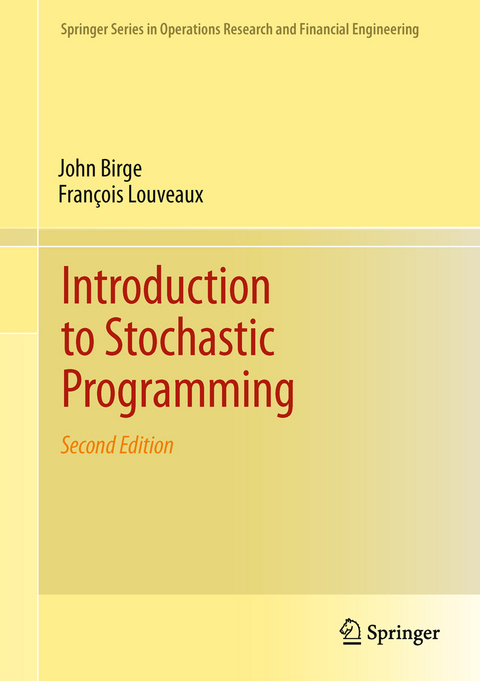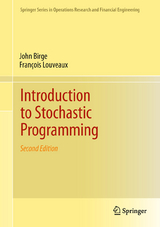Introduction to Stochastic Programming
Seiten
2011
|
2nd ed. 2011
Springer-Verlag New York Inc.
978-1-4614-0236-7 (ISBN)
Springer-Verlag New York Inc.
978-1-4614-0236-7 (ISBN)
In an extensively updated new edition, this book teaches stochastic programming, with new approaches for discrete variables, new results on risk measures in modeling and Monte Carlo sampling methods, a new chapter on relationships to other methods and more.
The aim of stochastic programming is to find optimal decisions in problems which involve uncertain data. This field is currently developing rapidly with contributions from many disciplines including operations research, mathematics, and probability. At the same time, it is now being applied in a wide variety of subjects ranging from agriculture to financial planning and from industrial engineering to computer networks. This textbook provides a first course in stochastic programming suitable for students with a basic knowledge of linear programming, elementary analysis, and probability. The authors aim to present a broad overview of the main themes and methods of the subject. Its prime goal is to help students develop an intuition on how to model uncertainty into mathematical problems, what uncertainty changes bring to the decision process, and what techniques help to manage uncertainty in solving the problems.
In this extensively updated new edition there is more material on methods and examples including several new approaches for discrete variables, new results on risk measures in modeling and Monte Carlo sampling methods, a new chapter on relationships to other methods including approximate dynamic programming, robust optimization and online methods.
The book is highly illustrated with chapter summaries and many examples and exercises. Students, researchers and practitioners in operations research and the optimization area will find it particularly of interest.
Review of First Edition:
"The discussion on modeling issues, the large number of examples used to illustrate the material, and the breadth of the coverage make 'Introduction to Stochastic Programming' an ideal textbook for the area." (Interfaces, 1998)
The aim of stochastic programming is to find optimal decisions in problems which involve uncertain data. This field is currently developing rapidly with contributions from many disciplines including operations research, mathematics, and probability. At the same time, it is now being applied in a wide variety of subjects ranging from agriculture to financial planning and from industrial engineering to computer networks. This textbook provides a first course in stochastic programming suitable for students with a basic knowledge of linear programming, elementary analysis, and probability. The authors aim to present a broad overview of the main themes and methods of the subject. Its prime goal is to help students develop an intuition on how to model uncertainty into mathematical problems, what uncertainty changes bring to the decision process, and what techniques help to manage uncertainty in solving the problems.
In this extensively updated new edition there is more material on methods and examples including several new approaches for discrete variables, new results on risk measures in modeling and Monte Carlo sampling methods, a new chapter on relationships to other methods including approximate dynamic programming, robust optimization and online methods.
The book is highly illustrated with chapter summaries and many examples and exercises. Students, researchers and practitioners in operations research and the optimization area will find it particularly of interest.
Review of First Edition:
"The discussion on modeling issues, the large number of examples used to illustrate the material, and the breadth of the coverage make 'Introduction to Stochastic Programming' an ideal textbook for the area." (Interfaces, 1998)
John R. Birge, is a Jerry W. and Carol Lee Levin Professor of Operations Management at the University of Chicago Booth School of Business. François Louveaux is a Professor at the University of Namur(FUNDP) in the Department of Business Administration
Introduction and Examples.- Uncertainty and Modeling Issues.- Basic Properties and Theory.- The Value of Information and the Stochastic Solution.- Two-Stage Recourse Problems.- Multistage Stochastic Programs.- Stochastic Integer Programs.- Evaluating and Approximating Expectations.- Monte Carlo Methods.- Multistage Approximations.- Sample Distribution Functions.- References.
| Reihe/Serie | Springer Series in Operations Research and Financial Engineering |
|---|---|
| Zusatzinfo | XXV, 485 p. |
| Verlagsort | New York, NY |
| Sprache | englisch |
| Maße | 178 x 254 mm |
| Themenwelt | Mathematik / Informatik ► Mathematik ► Angewandte Mathematik |
| Mathematik / Informatik ► Mathematik ► Computerprogramme / Computeralgebra | |
| Mathematik / Informatik ► Mathematik ► Finanz- / Wirtschaftsmathematik | |
| Wirtschaft ► Betriebswirtschaft / Management | |
| Schlagworte | Decision making under uncertainty • Dynamic Programming • stochastic optimization • Stochastik • Two-Stage Linear Recourse Problems |
| ISBN-10 | 1-4614-0236-0 / 1461402360 |
| ISBN-13 | 978-1-4614-0236-7 / 9781461402367 |
| Zustand | Neuware |
| Haben Sie eine Frage zum Produkt? |
Mehr entdecken
aus dem Bereich
aus dem Bereich
Anwendungen und Theorie von Funktionen, Distributionen und Tensoren
Buch | Softcover (2023)
De Gruyter Oldenbourg (Verlag)
69,95 €
Buch | Hardcover (2024)
Hanser (Verlag)
39,99 €




